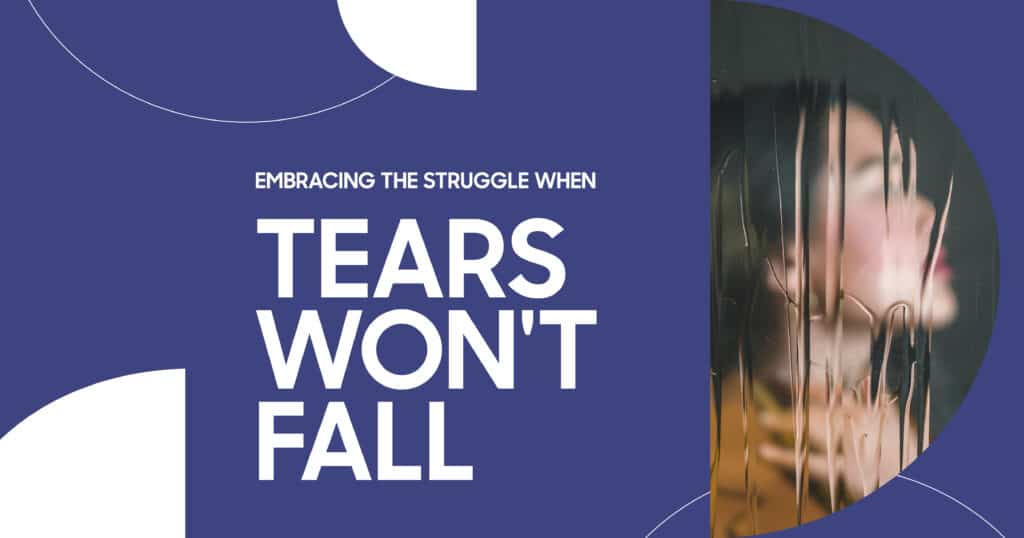There’s a unique kind of ache that comes not from crying, but from wanting to cry and being unable to. You feel it swell inside your chest, press behind your eyes, build in your throat – but the tears won’t fall. You whisper to yourself, “I want to cry, but I can’t,” and wonder what’s wrong. Why is the release so distant, the relief so inaccessible?
This invisible wall – an emotional block – can be one of the most painful forms of psychological tension. And while it may feel isolating, it’s more common than you think. Crying is a powerful form of emotional expression, and when it’s stifled or suppressed, it can leave the mind and body in a state of chronic unrest. In this blog, we’ll dive into the root causes of this emotional barrier, the psychological consequences, and how to invite your emotions back to the surface gently.
Causes of Suppressed Feelings and Emotional Block
Suppressing emotions doesn’t always happen consciously. Sometimes, it begins in childhood, when expressing sadness led to punishment or rejection. Other times, we learn to suppress tears in adulthood to appear “strong,” “tough,” or “stable.” Over time, this turns into a deeply ingrained response where vulnerability becomes a threat rather than a release.
The inability to cry when you want to can be caused by several factors:
- Early childhood emotional invalidation – being told to “toughen up” or “stop crying”
- Traumatic experiences – especially those where crying was unsafe or discouraged
- Fear of judgment or rejection – due to perceived weakness
- Perfectionism or high self-control – emotions may feel out of character or unacceptable
- Emotional fatigue or numbness – often due to chronic stress or unresolved grief
Treat Mental Health Texas
The Role of Stress and Anxiety in Emotional Pain
Stress and anxiety don’t just agitate the mind; they hold the body hostage too. The physical symptoms – tight chest, clenched jaw, racing heart – mirror the emotional tension that builds when we’re holding back tears.
Chronic stress keeps the body in a heightened state of alert, triggering the sympathetic nervous system (fight-or-flight mode), which can prevent the parasympathetic system (rest-and-digest mode) from doing its job – including supporting healthy emotional expression. According to the American Psychological Association, over 77% of adults report physical symptoms of stress, and 30% say they feel overwhelmed or sad frequently, yet many struggle to articulate or release those emotions through crying.
Here’s what typically happens:
- The mind perceives emotion as a threat or interruption.
- The body braces itself – tight muscles, shallow breath, stiffness.
- The tears that want to come out get caught in the crossfire between “I feel this” and “I must survive this.”
How Mental Health Conditions Affect Emotional Expression
Mental health conditions like depression, anxiety disorders, PTSD, and even burnout can dramatically influence one’s ability to cry or access emotions. Emotional numbness, or anhedonia, is a common symptom in these conditions, where one feels disconnected from feelings that once came easily.
In these cases, the emotional block isn’t just a coping mechanism – it’s a neurological one. Here’s a closer look at how different conditions can affect emotional expression:
| Condition | Impact on Emotional Expression |
| Depression | May cause emotional flatness, numbness, or inability to cry despite feeling deeply |
| Anxiety Disorders | Heightened alertness can lead to emotional overload or suppression |
| PTSD | Defense mechanisms may prevent emotional release as a survival strategy |
| Burnout | Emotional exhaustion often leads to detachment and apathy |
| Bipolar Disorder | During depressive phases, emotional responsiveness may be dulled or absent |
The Impact of Societal and Cultural Norms on Vulnerability
From a young age, we are taught how – and how not – to express emotions. In many cultures, especially for men, crying is labeled as weak, dramatic, or inappropriate. These cultural norms don’t just shame vulnerability – they silence it.
Over time, internalized beliefs such as:
- “Crying is a sign of failure.”
- “Real adults don’t break down.”
- “You need to keep it together.”

Treat Mental Health Texas
Ways to Facilitate Emotional Release and Encourage Tears
If you say, “I want to cry but I can’t,” you’re already halfway there. Awareness is the first step toward emotional healing. The next step is creating conditions that invite safety, softness, and expression.
Here are several gentle practices that can help facilitate emotional release:
- Create a quiet, safe space where you feel emotionally secure and free from judgment.
- Listen to emotionally resonant music – songs that once made you cry or move you emotionally.
- Watch films or read stories that trigger empathy and sadness.
- Engage in deep breathing exercises, which help signal to the body that it’s safe to relax and feel.
- Journal without filtering – write exactly how you feel, even if it doesn’t make sense.
- Use guided meditation or visualization to connect with inner emotional experiences.
- Talk to someone you trust – sometimes emotions flow when we’re simply seen and heard.
Therapeutic Techniques for Overcoming Emotional Blocks
While self-practices are powerful, professional support can offer the structure and safety needed to truly break through an emotional block. Therapy provides a space to explore underlying causes and heal in ways that feel both supported and sustainable.
Below are evidence-based therapeutic techniques that can help restore emotional expression:
| Therapeutic Approach | How It Helps with Emotional Block |
| Cognitive Behavioral Therapy (CBT) | Identifies and reprograms beliefs that suppress emotions |
| Somatic Therapy | Connects emotional patterns to physical sensations for release |
| Eye Movement Desensitization and Reprocessing (EMDR) | Processes trauma that may be inhibiting emotional flow |
| Internal Family Systems (IFS) | Helps identify protective parts that block vulnerability |
| Expressive Arts Therapy | Uses art, music, or writing to unlock deeper emotional currents |
The Importance of Embracing Vulnerability for Mental Health
Vulnerability is not weakness – it’s the gateway to connection, compassion, and emotional resilience. Yet, for many, showing sadness or crying feels unsafe or embarrassing. This mindset becomes a barrier not only to crying, but to healing.
When we embrace vulnerability, we grant ourselves permission to:
- Be seen and understood without performance.
- Accept that pain is part of the human experience.
- Release rather than bottle emotions that fester.
Let It Out – Find Compassionate Support at Treat Mental Health Texas
If you’ve been stuck in emotional silence, know this: you’re not broken. You’re likely overwhelmed, overprotected, or simply carrying too much for too long. At Treat Mental Health Texas, we understand the pain of suppressed emotions, the quiet struggle of wanting to cry but being unable to, and the deep need for release.
Our therapists offer personalized care tailored to your emotional journey. Whether you’re processing trauma, managing depression, or learning how to access feelings that have long been buried, we’re here to walk with you – gently, patiently, and without judgment.
Contact Treat Mental Health Texas and let your healing begin in a space where every emotion is welcome, including the ones that haven’t yet found their way to the surface.

Treat Mental Health Texas
FAQs
- What are some effective methods for facilitating emotional release and encouraging tears in a healthy way?
Creating a safe space, journaling, listening to emotional music, watching cathartic films, and practicing deep breathing can help ease emotional blocks and allow tears to flow.
- How do suppressed feelings and emotional blocks contribute to mental health challenges?
Emotional suppression can lead to chronic stress, anxiety, depression, and physical symptoms like fatigue or muscle tension, as the body holds onto unresolved emotional energy.
- In what ways do societal and cultural norms impact our vulnerability and emotional expression?
Many cultures view crying as a weakness, particularly among men, which leads individuals to suppress their emotions in fear of judgment, creating long-term emotional disconnection.
- Can stress and anxiety create emotional pain and hinder the natural flow of tears?
Yes, high levels of stress and anxiety activate the body’s fight-or-flight response, which can block the relaxation needed for emotional release and inhibit the ability to cry.
- What therapeutic techniques can help individuals overcome emotional blocks and embrace vulnerability?
Techniques like CBT, EMDR, somatic therapy, and expressive arts therapy provide tools to safely explore and release suppressed emotions, fostering reconnection with one’s emotional self.










